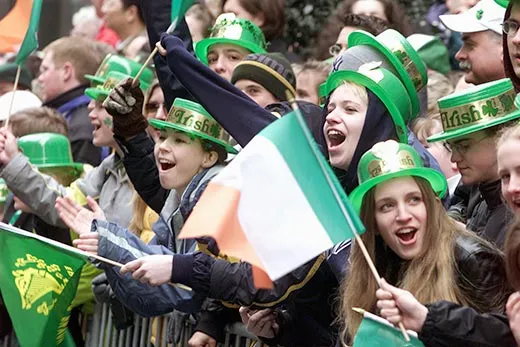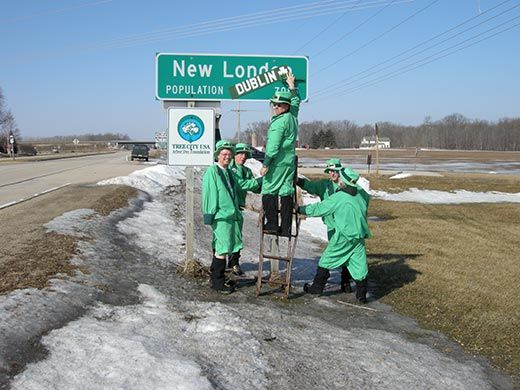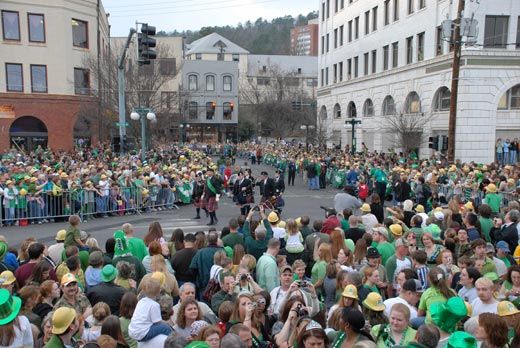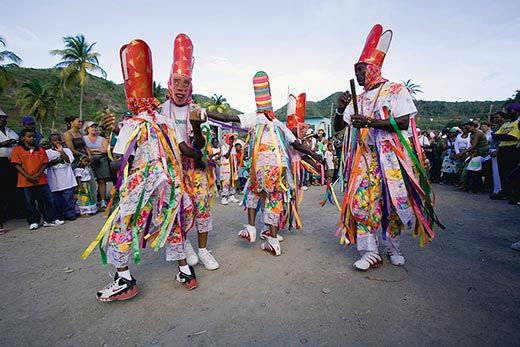Unusual St. Patrick’s Day Celebrations
Leprechauns and green shamrocks are only a part of celebrating St. Patrick’s Day for Irish communities around the world
/https://tf-cmsv2-smithsonianmag-media.s3.amazonaws.com/filer/Saint-Patricks-Day-Parade-631.jpg)
Since the early 17th-century St. Patrick’s Day has been one of celebration. Each March, cities and towns pay tribute to the Emerald Isle – Chicago dyes its river a glowing green and New York City draws two million spectators to its parade. And as local customs meld with leprechauns, shamrocks and bagpipes, communities around the world are adding a new twist to traditional St. Patrick’s Day festivities.
1) Hot Springs, Arkansas
The world’s shortest St. Patrick’s Day parade may also be the quirkiest. Across the 98-foot-long Bridge Street, labeled in the 1940s as the “Shortest Street in the World” by Ripley’s Believe It or Not, march a cast of characters, including the Famous San Diego Chicken, Irish Elvis impersonators and the Lards of the Dance, a troupe of middle-aged Irish dancers. This year’s events also feature the world’s shortest wedding ceremony at under a minute, as well as the “Romancing the Stone” competition, in which the parade-goer with the most original kiss for an impromptu Blarney stone wins a $100 prize. Also making an appearance, Dr. Albert Habeeb, who at 95 years old is the self-proclaimed “World’s Oldest Leprechaun.”
“It's not devoted to a bunch of blarney about being Irish,” says Paul Johnson, spokesman for the six-year-old parade. “It’s devoted to having fun.”
2) Montserrat, Caribbean Sea
Considered the other Emerald Isle, Montserrat is the only other place outside of Ireland that celebrates St. Patrick’s Day as a national holiday. A small percentage of the Caribbean island’s nearly 4,500 people are descended from Irish Catholic settlers. March 17 also marks the anniversary of a 1768 slave uprising on the island. Though the revolt was unsuccessful, Montserrat abolished slavery in 1834.
“What makes Montserrat so unique is it has an equally Irish and African heritage,” says island spokeswoman Jennifer Johnson. “It fuses the cultures in perfect harmony.” During the weeklong St. Patrick’s Day celebrations, steel drum bands play, Creole breakfast is served and residents take part in a Freedom Run, which commemorates the emancipation of both Irish indentured servants and African slaves.
3) O’Neill, Nebraska
At the intersection of Route 281 and Highway 20, the world’s largest shamrock, a large green clover painted in the middle of the road, reminds visitors to O’Neill that the community of 39,000 is the official Irish capital of Nebraska. John O’Neill, the town’s namesake, was a native Irishman and veteran of the Civil War and strong proponent of Irish immigration to the Plains state. He wrote pamphlets and distributed them to immigrants working the Appalachian coal mines, heralding the virtues of owning and farming tracts of land.
Each St. Patrick’s Day, the town celebrates its Irish forebears with an odd array of festivities that include a hypnotist, fish fry and Children’s Literature Festival featuring the reading of Dr. Seuss’s “Green Eggs and Ham.” The installation of a huge Blarney stone on the southwest corner of the shamrock intersection will be one of this year’s highlights. “In March, everyone just steps a little higher and smiles a little broader,” says City of Commerce member Pat Fritz.
That’s why the merriment won’t end on St. Patrick’s Day; on the 17th of every month to follow, residents will wear green to commemorate the town’s heritage.
4) Brisbane, Australia
Up to 30 percent of Australians claim some Irish heritage and there are over 50,000 Irish-born residents in Australia, according to the Australian Embassy in Ireland.
Among the celebrations is the Queensland Irish Association parade. The event portrays “The Irish Historical Story,” how men, women and children of all trades and professions were sent to Australia to help build a nation. Now in its 20th year, the march through the main streets of Brisbane City presents residents dressed up as teachers, widows and orphans, sugar cane cutters, gold miners, lawyers and stockmen.
5) New London, Wisconsin
St. Patrick’s Day officially begins in New London when the Shamrock Club, a group of residents dressed as leprechauns, sneakily changes highway signs to read New Dublin, an idea that received laughs and eventual city council approval over 20 years ago. Although German immigrants originally settled the town, an influx of Irish residents in the 19th century forever changed the town’s traditions. Now, every March, corned beef and cabbage appear on the menu at local restaurants, Irish carolers sing at the senior citizens' home and Shamrock Club members a.k.a. leprechauns, visit hospitals and schools.
The parade draws 30,000 people to the town of 7,000. In addition to a staged Finnegan’s Wake (a shout-out to the final work of Irish author James Joyce, in which a green-painted hearse drives down the parade route), bagpipe players and the high school band march down the street, following a trail of shamrocks painted on the pavement. The grand finale is “Irish Fest,” which brings Celtic bands like Rising Gael and Seven Nations to perform for visitors underneath a huge heated tent, as the average high temperature in New London is 39 degrees Fahrenheit.
6) Banwen, Wales
Members of the Banwen & District History Club in Wales, England, claim the patron saint of Ireland wasn’t Irish at all, but a local Welshman. According to their historians, St. Patrick was born Maewyn Succat in Banwen in A.D. 385, kidnapped by pirates at the age of 16 and sold into slavery in Ireland. On St. Patrick’s Day, members of the organization join Welsh pipers in a parade down Roman Road in Banwen toward a stone commemorating St. Patrick’s birthplace.
7) Ise, Japan
Marchers gather at the Ise Shrine, dedicated to the sun goddess Amaterasu of the Shinto religion to kick off this St. Patrick’s Day celebration in the Mie Prefecture of Japan. When the parade begins, the flags of Japan and Ireland fly side-by-side, and Japanese residents do jigs, play bagpipes and dress up like leprechauns and St. Patrick to entertain the children. Over 500 marchers, including the Irish ambassador to Japan and the town’s mayor take part. Afterward participants shuck and bake shellfish at an oyster festival that celebrates local commerce.
The parade is co-organized by the Irish Network of Japan, which plans events in Tokyo, Okinawa and elsewhere in Japan to promote a cultural exchange between the two countries.
Share your tales of more unusual St. Patrick’s Day Celebrations in the comments area below.
/https://tf-cmsv2-smithsonianmag-media.s3.amazonaws.com/accounts/headshot/joseph-caputo-240.jpg)





/https://tf-cmsv2-smithsonianmag-media.s3.amazonaws.com/accounts/headshot/joseph-caputo-240.jpg)